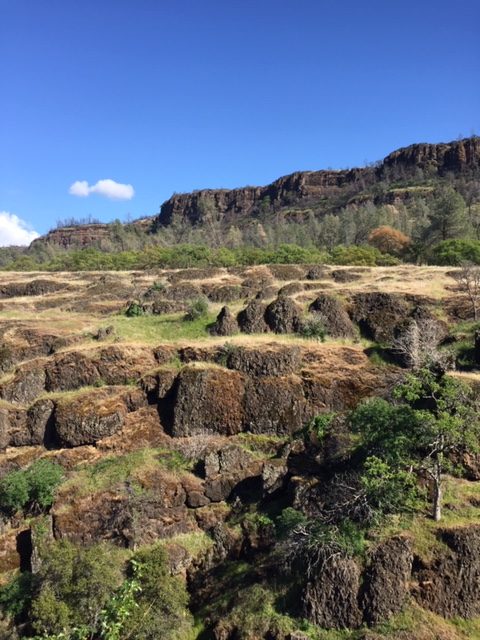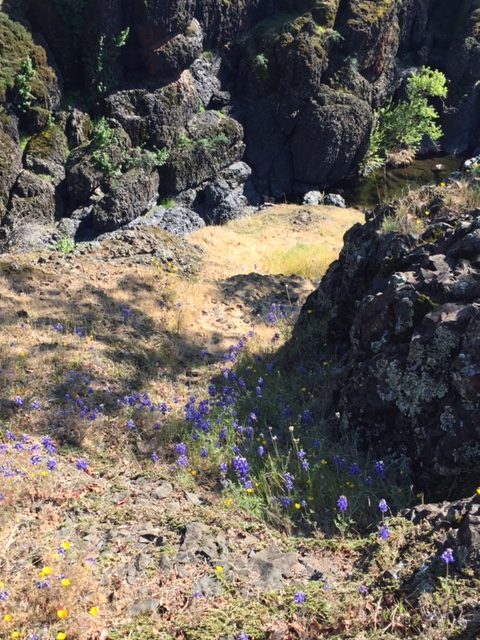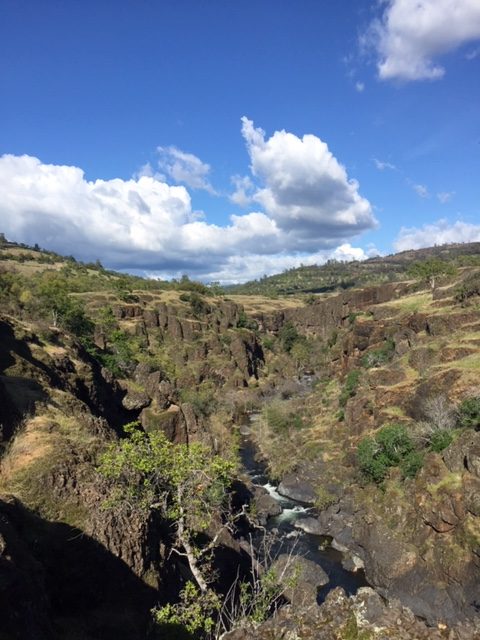The canyon was so unexpectedly beautiful that I literally felt a little disoriented climbing the trail to my usual meditation spot overlooking the gorge.
Thousands of lupines, mixed with a few orange poppies, lined the path, painting the steep slopes in delicate blue down to the dark, volcanic slabs that form the vertical walls of the gorge. The faint, sweet smell from the lupines wafted up on the soft breeze as I sat in the late afternoon sun.
After a few days of rain recently, the slopes are green, though not lushly so. There was insufficient rain during the winter, and it looks like it will be another drought year in California, which means more and earlier wildfires during the dry season.

A half-mile up the canyon, at the far end of the gorge, a young man sat cross-legged for half an hour. On his way back on the path behind me, I asked if he was meditating. He gave a non-committal answer, indicating an attempt to do so.
I commented on the beauty of the canyon today, and the surprising number of lupines in bloom. “What are lupines?” I pointed to a line of them next to us, and he smiled. “I come here to heal,” he said. Yes, we all need healing, I replied. The incisive conversation only lasted about a minute, and we kept our mandated social distance.
As reported in the national news, “On Thursday, Gov. Gavin Newsom of California commanded the people of his state to stay home. That’s roughly 40 million people. He anticipates that about 25 million Californians will be infected by the virus over the next eight weeks.”
I’ve never seen as many people in Upper Park however. It’s the jewel of Chico, which stretches for about 8 miles into the canyon just beyond town. Numerous cars were in the gravel parking areas, and in pullouts along the bumpy, unpaved road. People weren’t ignoring Newsom’s order, just getting out into nature while staying clear of each other.
All the folks I crossed paths with were courteous and friendly. Having endured the worst wildfire in California history less than two years ago, which killed 85 people, destroyed the ironically named town of Paradise, and burned down nearly 20,000 homes and businesses in a matter of hours, people in this locality aren’t about to go bananas over a virus.
At the last parking area before a permanently closed gate into the upper reaches of the canyon, a ranger was opening the lock. ‘You’re not opening the gate I’ll bet,’ I said after shouting hello. He smiled and walked halfway to the car.
“Unfortunately no. I’m nearing the end of my shift and though I usually hike up to Salmon Hole [a favorite gathering and swimming spot for students at Chico State], I’m driving up to check things out.”
As I meditated overlooking the stupendous gorge, with a view miles up-canyon and sheer cliffs rising hundreds of feet in front of me less than a mile away, two young men went by with fishing poles strapped to their daypacks. “Nice spot,” one understatedly said.
After they passed, I let a sneeze rip without restraint. Through a small opening between the jagged rocks on the path 100 meters away, one of the guys turned and waved.
Group meditation is an oxymoron. The origin of separation and alienation is the primal habit of the observer. To end the observer, one has to intently watch the stream of thought/emotion alone in the mirror of nature, allowing awareness to grow quicker than thought.

The very act of passively observing, including without strengthening the illusorily separate observer that judges and chooses, gathers unwilled attention, which in turn clears the muddy stream within.
It’s like watching a brown, turbulent creek, full of debris after a heavy rain. Except that the very act of attending to thoughts and emotions as they arise clears the stream. Then, always unexpectedly, it stops, leaving only the ever-pregnant silence of being.
Huge flocks of Canadian geese, flying high overhead, flashed silver as they circled in the sun. Other than the sound of a small plane, there was no noise of man, only the sound of the stream far below, mixed with the calls of some unknown bird.
Vultures soared by so close that I could see their heads swivel as they scanned the ground, or me, for carrion. Suddenly, in the distance, a paraglider appeared. He or she seemed to hover motionless against the cliff-face for seconds at a time.
Then, with exquisite grace, the pilot made a series of banking turns, before descending to a flat about a mile up the canyon. Social distancing collapsed as the huge semi-circular sail crumpled to the ground.
Martin LeFevre

